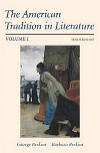 |  The American Tradition in Literature, Volume 1, 10/e George Perkins,
Eastern Michigan University
Barbara Perkins,
University of Toledo-Toledo
OrientationMost critics characterize Hawthorne as an observer of the human condition, standing apart and setting up the great moral dilemmas through which his characters must chart their course. He made rich use of his Puritan heritage ("The Maypole of Merry Mount"), although he was no celebrant of ancestorys who included a magistrate in the Salem witch trials, the backdrop for "Young Goodman Brown." Obscurity of place, circumstance, and choices create conflicts through which characters move only tenuously ("My Kinsman, Major Molineau"). The "hero of the quest" ("Ethan Brand," "Rappaccini's Daughter") is often thwarted by short-sighted moral vision. The nature of sin is inevitably traced to the ambiguities of human nature, divided between the necessity to do good and a penchant for evil, and an inability of his characters to accept this duality as the legitimate definition of the human condition ("Young Goodman Brown," "The Minister's Black Veil"). |
|



 2003 McGraw-Hill Higher Education
2003 McGraw-Hill Higher Education